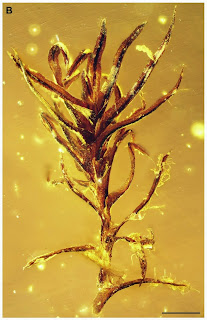Imagine the world millions of years ago. Covered in plants and dominated by dinosaurs.
 Mosses were a critical component of the lush green background, but you wouldn't know it from the fossil record. Unfortunately there are not many moss fossils. They break down more rapidly than other woody plants and thus there is less fossil evidence of their history on the planet.
Mosses were a critical component of the lush green background, but you wouldn't know it from the fossil record. Unfortunately there are not many moss fossils. They break down more rapidly than other woody plants and thus there is less fossil evidence of their history on the planet.  |
| Calymperites burmensis sp. nov. fossilized in amber. Heinrichs et al. 2014 |
Finding new moss fossils, especially well preserved ones, represents an important scientific discovery. Recently a new species of moss was described from a plant found in amber (fossilized tree resin). Originally this piece of amber was intended to be a necklace, but now lives at the American Museum of Natural History in New York where it can be studied by scientific researchers and potentially viewed by the public.
The closest living moss relatives to this fossil moss were determined based on its physical features. Based on this data, the species is in the moss family Calymperaceae. No DNA was mined out of this preserved specimen. Unfortunately recovering DNA from amber fossils only happens in the science fiction of Jurassic Park.
Fossils, like this one, are an important addition to our scientific knowledge. They help us to determine the timing of moss evolution and to date evolutionary trees. This gives us a better understanding of when particular groups evolved and which groups were present during the prehistoric times of the dinosaurs.
For more on ancient plants, check out this episode of Plants Are Cool Too!

















